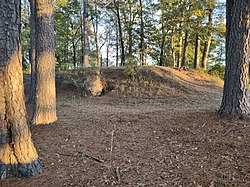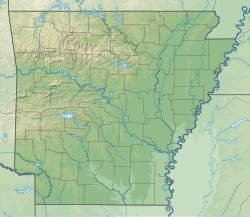United States historic place
| Fort Southerland | |
| U.S. National Register of Historic Places | |
| U.S. National Historic Landmark | |
 Fort Southerland Park in 2022 Fort Southerland Park in 2022 | |
 | |
| Location | Camden, Arkansas |
|---|---|
| Coordinates | 33°34′26″N 92°49′05″W / 33.57389°N 92.81806°W / 33.57389; -92.81806 |
| Built | 1864 |
| NRHP reference No. | 94001184 |
| Significant dates | |
| Added to NRHP | April 19, 1994 |
| Designated NHL | April 19, 1994 |
Fort Southerland, also known as Redoubt E and possibly Fort Diamond, is a redoubt built during the American Civil War to protect Camden, Arkansas. Confederate forces built it along with four other redoubts in early 1864 after a Union victory in the Little Rock campaign the previous year. Fort Southerland is about the size of a city block and is roughly oval. It could hold three cannons. When Union forces captured Camden in April 1864 during the Camden Expedition, they improved the defenses of the five redoubts, which were not sufficient for proper defense of the city. After the Confederates retook Camden later that month, they continued to improve the city's defenses.
The fort lies within Fort Southerland Park, a municipal park dedicated in 1974. It was listed on the National Register of Historic Places in 1994, and is part of the Camden Expedition Sites National Historic Landmark. Along with Fort Lookout (Redoubt A), it is one of only two of the redoubts around Camden still in existence.
History
Construction
In 1863, during the American Civil War, Union forces captured Little Rock, Arkansas. The defeated Confederates then withdrew to Camden, Arkansas, which was along the Ouachita River. Towards the end of the year, Confederate General E. Kirby Smith ordered a series of forts built around Camden, in hopes of deterring a Union assault. Brigadier General Alexander T. Hawthorn, a pre-war resident of the area, was tasked with planning the defenses, although he lacked experience in military engineering. Slave labor and hundreds of soldiers were used to build the positions. In all, between January and April 1864, five positions were constructed. They are generally referred to as forts, but, according to historian William L. Shea, are more accurately termed redoubts due to their smaller size.
One of these redoubts was Redoubt E. It has been known by the name of Fort Southerland, although Shea states that the accuracy of this identification is questionable, and historian Mark K. Christ notes that local sources suggest that Redoubt D was known as Fort Southerland and Redoubt E's true name was Fort Diamond. Redoubt E was constructed south of Camden and was intended to guard against a Union crossing of the Ouachita from south of town, although this possibility was considered to be unlikely. The position covered the Bradley Ferry Road, which connected Camden with Confederate-occupied Monticello and Warren. It was more than 1 mile (1.6 km) southeast of the other redoubts, and was constructed on a hilltop in what Shea refers to as "splendid isolation". Made of earth, it is roughly 2,000 by 1,000 by 2,000 by 500 feet (610 m × 300 m × 610 m × 150 m) in size and about the size of a city block. It could hold three cannons, although the other four redoubts could emplace more. The position was also defended by a ditch. The area was mostly cleared of trees during the 1864 periods of work, but as of 1993 there were several trees at the site, which contributed to erosion prevention.
Camden Expedition
In early 1864, Union Major General Frederick Steele learned about the Confederate fortifications at Camden, and when beginning the Camden Expedition in March decided to veer to the west and move through Arkadelphia instead to avoid the positions at Camden. Steele had intentions of attacking the Confederate-held city of Shreveport, Louisiana. To respond to the Union offensive, Confederate Major General Sterling Price moved his troops out of Camden to confront Steele. After the Battle of Prairie D'Ane, Steele decided that supply problems would prevent him from taking Shreveport, and decided to capture Camden instead; his men reached it on April 15. The city's defenses were not occupied at this time, as Price had moved his men towards Washington, where both he and Smith expected the Union attack to strike. Upon reaching Camden, the Union troops found that the Confederate positions were not particularly strong: the five redoubts were too small, too far apart, and were not connected by trenches. In places, the field of fire of the positions was limited by incomplete clearing and enemy troops could advance under the cover of forests.
While Steele's command occupied Camden, Union supply trains were captured in the battles of Poison Spring and Marks' Mills, and Confederate forces feinted against Camden. Steele decided that the defenses of Camden needed improvements and, beginning on April 23, had his men construct trenches and rifle pits. The Union forces withdrew on April 26, as they were running out of food and Steele had learned that the Red River campaign had ended in a Union defeat. The Confederates re-occupied Camden and did further work on the fortifications, including building the Camden Water Battery. A line of trenches connecting the redoubts was completed in late 1864. The post-occupation Confederate work may have been done simply to keep idle troops busy.
Postwar
The remains of three of the redoubts were obliterated in the postwar period. One was covered over by urban development in the early 1900s, another is now a cemetery, and the rough site of one has been the location of a water tower since before 1982. The fourth, Redoubt A, also known as Fort Lookout, was partially destroyed in the 1960s when a house was built on it. Part of the line of trenches survived into the early 1970s. Redoubt E was well south of the city when it was constructed, but Camden's growth expanded towards the north and west sides of the site. Fort Southerland Park, a 5.5-acre (2.2 ha) municipal park containing the remains of the fort, was dedicated in 1974. A 1987 request to add Fort Southerland Park to the Arkansas state park system was not acted on, lack of funds and manpower to take on new units and the small size of the park being reasons for the refusal.
Both Fort Southerland and Fort Lookout were part of the National Historic Landmark (NHL) multiple listing nomination for the Camden Expedition Sites National Historic Landmark in 1993. Fort Southerland itself was listed on the National Register of Historic Places and as part of the Camden Expedition Sites NHL on April 19, 1994. Describing the destruction of much of the earthworks at Camden and other points in Arkansas, Shea finds it "sad to note how little has survived". Christ considers that Fort Southerland and the remains of Fort Lookout are "remarkably well-preserved". The NHL nomination form describes Fort Southerland as having "excellent integrity of setting, feeling, association, and location" and that it "represents an excellent preserved example of urban Civil War defensive earthworks". As part of the park, the site is publicly accessible and is marked with interpretative signage. Picnic areas have been developed there.
See also
- List of National Historic Landmarks in Arkansas
- National Register of Historic Places listings in Ouachita County, Arkansas
References
Citations
- Shea 1982, pp. 318–319.
- Shea 1982, p. 319.
- ^ Christ, Mark K. (September 8, 2021). "Forts Lookout and Southerland". Encyclopedia of Arkansas. Retrieved 2 July 2022.
- Shea 1982, pp. 319–320.
- ^ Shea 1982, p. 321.
- ^ Baker 1993, p. 6.
- ^ Shea 1982, pp. 320–321.
- Shea 1982, pp. 321–322.
- Baker 1993, p. 7.
- Castel 1993, pp. 174–175.
- Shea 1982, p. 323.
- ^ Shea 1982, pp. 323–324.
- Baker 1993, p. 8.
- Castel 1993, p. 179.
- ^ Shea 1982, p. 325.
- Christ, Mark K. (October 12, 2021). "Camden Water Battery". Encyclopedia of Arkansas. Retrieved 30 July 2022.
- ^ Bearss 1993, p. 14.
- "Mayor Dedicates Fort Southerland Park". The Camden News. June 25, 1974. Retrieved 2 July 2022.
- "Ark. Park Request Denied". The Times (Shreveport, Louisiana). October 17, 1987.
- Bearss 1993, p. 1.
- Shea 1982, p. 326.
- Christ 1994, p. 170.
- "Fort Southerland Park". Arkansas Department of Tourism. Retrieved 2 July 2022.
Bibliography
- Baker, Don (January 25, 1993). "National Register of Historic Places Nomination Form: Fort Southerland - Red River Campaign". Arkansas Preservation. Retrieved 2 July 2022.
- Bearss, Ed (November 29, 1993). "National Historic Landmark Nomination: Camden Expedition Sites". National Park Service. Retrieved 2 July 2022.
- Castel, Albert E. (1993) . General Sterling Price and the Civil War in the West. Baton Rouge, Louisiana: Louisiana State University Press. ISBN 0-8071-1854-0.
- Christ, Mark K., ed. (1994). Rugged and Sublime: The Civil War in Arkansas. Fayetteville, Arkansas: University of Arkansas Press. ISBN 1-55728-357-5.
- Shea, William L. (1982). "The Camden Fortifications". Arkansas Historical Quarterly. 41 (2): 318–326. doi:10.2307/40038521. JSTOR 40038521.
External links
 Media related to Fort Southerland at Wikimedia Commons
Media related to Fort Southerland at Wikimedia Commons- "Fort Southerland". Tripadvisor.
| U.S. National Register of Historic Places | |
|---|---|
| Topics | |
| Lists by state |
|
| Lists by insular areas | |
| Lists by associated state | |
| Other areas | |
| Related | |
- 1864 establishments in Arkansas
- American Civil War forts
- American Civil War on the National Register of Historic Places
- Arkansas Heritage Trails System
- Camden Expedition Sites National Historic Landmark
- Forts on the National Register of Historic Places in Arkansas
- National Register of Historic Places in Ouachita County, Arkansas
- Parks in Arkansas
- Redoubts
- Tourist attractions in Ouachita County, Arkansas